Leadpages Review: Is It Still the Best Landing Page Creator Around?

When you buy something through one of the links on our site, we may earn an affiliate commission.
Welcome to our Leadpages review.
There have been substantial innovations in the marketing industry over the years. And yet, marketers are still bound to opt-in landing pages and pop-ups to generate new leads.
For less tech-savvy folks, however, creating a landing page from scratch is not an option. You could say the same for entrepreneurs with little to no marketing dollars to spare.
That's where Leadpages comes in. As you'll discover in this Leadpages review, the web-based platform promises to give you the landing page tools you'll need to publish high-converting landing pages for your lead-generation campaigns.
Try Leadpages for 14 Days Free Right Here!
Get a 14-Day Free Trial of Leadpages HereLead Pages Review
-
Ease of Use - 95
-
Stability - 95
-
Customer Service - 95
-
Price - 85
Summary
Leadpages is the perfect choice for people with the money to spend on a tool that will let them create beautiful and high-converting landing pages and opt-in boxes. Try Leadpages for 14 Days Free Right Here!
Pros
- Ease of use
- Loads of templates
- Easy integration
- Leadboxes
Cons
- Quirk landing page builder
- Standard templates
- A/B testing for Pro users and above
Contents
Leadpages Review Overview
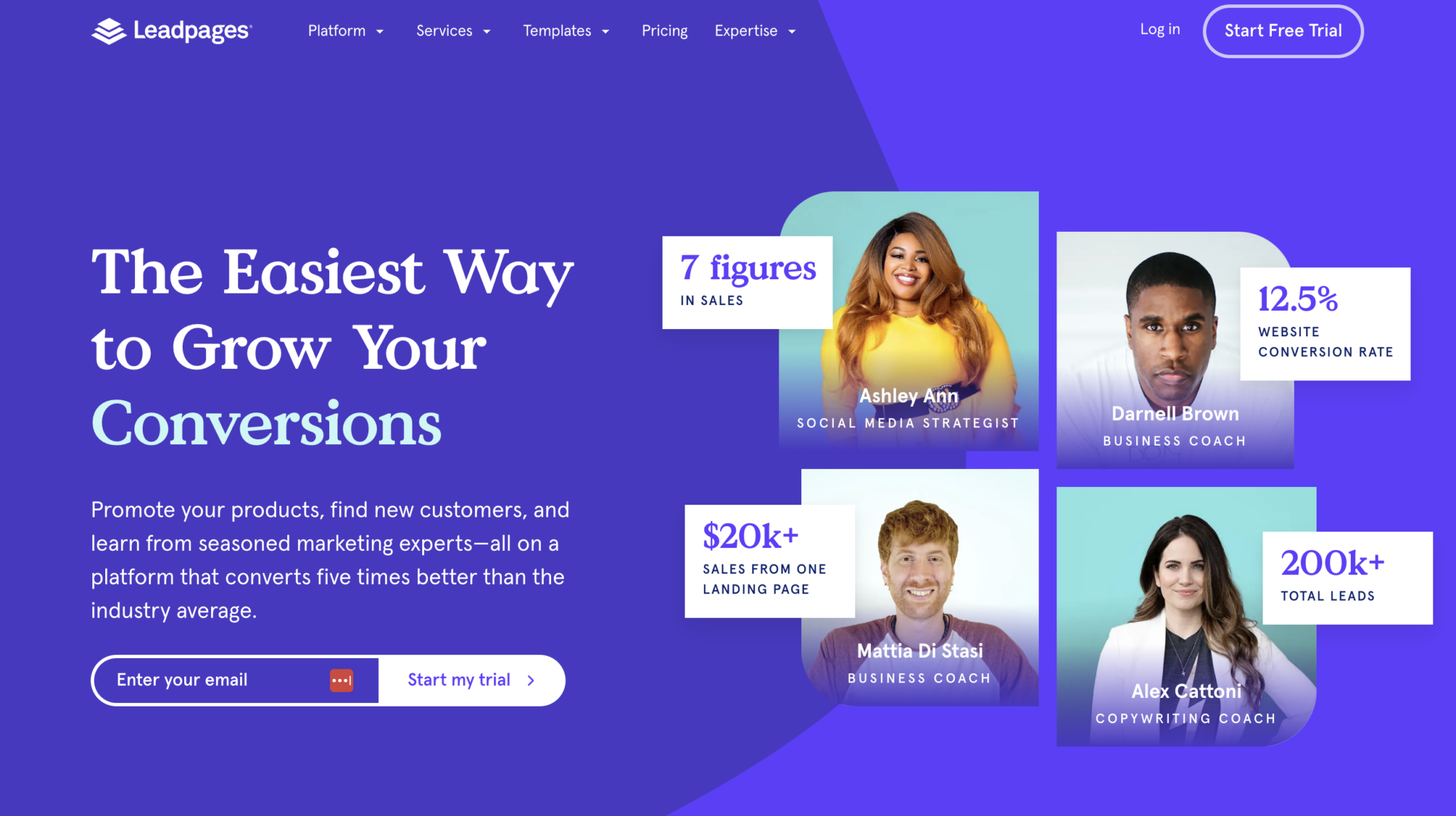
Leadpages is designed to help its users make beautiful landing pages — all without the need for design or coding experience. Through these landing pages, users will be able to prompt users to provide their email or other relevant information.
At the heart of Leadpages is the Leadpage Editor, an easy-to-use tool that enables users to work with templates and edit the details as needed. You will see later how the editor works.
On top of that, the company also offers other features to further help their users make the most of their lead generation campaigns.
Pros and cons of Leadpages
Honestly, there's a lot to like from our Leadpages review. But the tool is far from perfect. Let's break down the pros and cons.
Pro: Ease of use
For the average user, Leadpages will be more than enough to fulfill your lead generation goals. At the end of the day, all you need is a presentable landing page that will wow your audience. Leadpages is more than capable of getting the job done. It truly does not require any prior coding or design experience.
Pro: Loads of templates
The sheer number of available templates would be more than enough to get you started on the right track. There's a template for virtually every situation. Options range from webinar pages, thank you pages, product launch pages, checkout pages, and even 404 pages. Leadpages claim they have at least 160 free templates in their library.
Pro: Easy integration
You can use Leadpages no matter what CMS you're using. It can support WordPress, Joomla, Squarespace, and more.
Pro: Leadboxes
The bulk of this Leadpages review was focused on the landing page builder (see also Leadpages alternatives), but let's not forget that subscribers also get access to Leadboxes. There's no denying the fact that pop-up boxes are effective and can result in conversions that would otherwise be missed if not for Leadboxes.
Leadpages Review Con: Quirky landing page builder
The drag-and-drop functionality issues need to be addressed. People who are very particular about their landing page designs can struggle with the tool's interface. The tool can also slow down every now and then when building landing pages, which can be troublesome, especially for individuals who are on a tight deadline.
Con: Standard templates
Leadpages themselves encourage users not to use their standard templates. There are barely any customization options with the standard Leadpages templates. The drag-and-drop feature is unavailable for standard templates. So even if you do find a template worth using in their dated selections, you'd be unable to customize them as you see fit.
CON: A/B Testing for Pro Users and Above
There's no denying the importance of A/B testing. It's the only way to see which pages are working and which ones need refinement. Unfortunately, standard users have no access to A/B testing and need to upgrade to a higher plan to make use of the feature.
Overall, Leadpages is a good pick to build your landing pages. It's not a perfect solution, but it's better than the competition and is pretty user friendly.
Not sure if Leadpages is right for you? Click here to try Leadpages free for 14 days.
Convert visitors to leads with LeadpagesLeadpages Review: Features
There are many reasons why Leadpages, to this day, is still a go-to source for users who need landing pages fast. Here are some of the features the company has to offer.
Leadpages (Landing Page Creator)
The Landing Page Creator makes use of drag-and-drop functionality which makes it easier for customers to create custom landing pages that suits their needs.
To get you started, there are over 100 templates to choose from and can be filtered by industry. The templates are sorted by conversion rate which is quite useful. It provides users with an opportunity to pick a proven template based on Leadpages' data.
Do note, however, that there are many factors that affect conversion rate. Because the templates are customizable, it's hard to attribute conversion to the template by itself. For what it's worth, Leadpages claims it as its most powerful and unique sorting feature.
The templates are a mix of in-house and third-party offerings. Any template that's not developed by Leadpages itself needs to be paid for to use. Hosting is included in your subscription.
You can perform A/B testing so you can determine which landing pages work best and optimize your landing pages for conversion. You can evaluate your performance through the built-in analytics (you can integrate it with Facebook Pixel and Google Analytics).
Templates are responsive so mobile users shouldn't have a problem viewing your landing pages even when they're on their phones.
You will see how Leadpages work later down the article.
Leadboxes
If you've ever encountered pop-up boxes that appear just as you're about to leave a site, you've probably encountered Leadboxes.
This nifty box can either pop up automatically or be triggered by a condition you set. The most popular condition is arguably the 2-step opt-in, where a visitor has to click a button for the pop-up box to appear.
If done right, Leadboxes could increase engagement and result in more leads for your business. As with the landing pages, there is a drag-and-drop editor for Leadboxes to make it easier for users to get up and running in minutes.
To create one, click on “Create a Leadbox.”
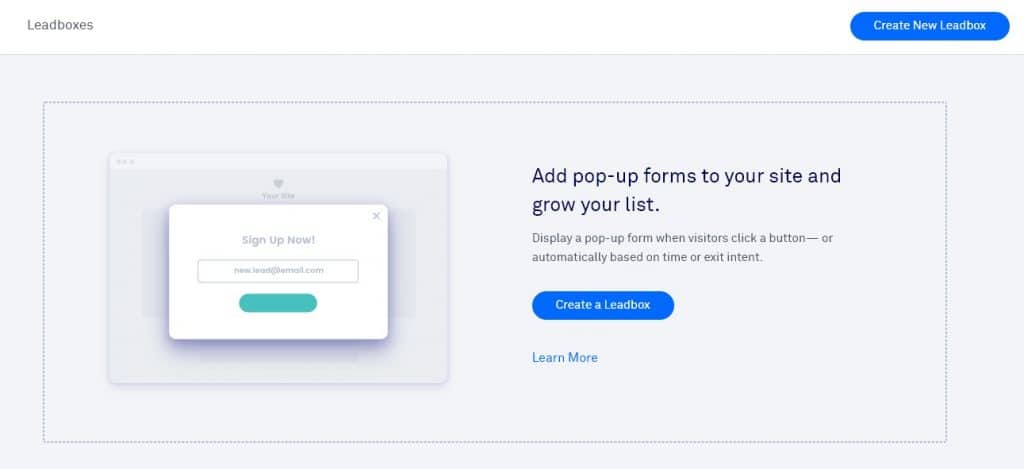
From here, you can edit the Leadbox at your bidding. It has a drag-and-drop editor that makes coming up with a design for your Leadbox very easy.

The Leadbox Layout lets you fix the overall design of the opt-in form. You can change the background image, padding, timing control, and others to get the most out of your Leadbox.

Leadbox Tracking lets you capture and analyze data of your opt-in boxes to see how it performs over time. Connect your Google Analytics or Visual Website Optimizer to gather information that will help you make sense of your boxes.
Leadpages Review: Leadlinks
Leadlinks are links that you insert into your broadcast emails through your email service provider.
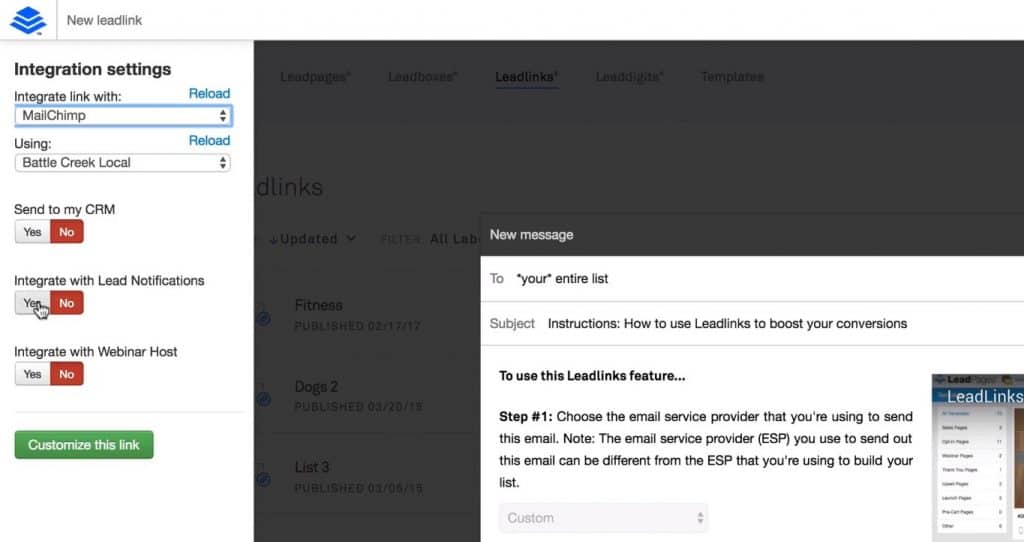
Once the recipient clicks on that link, they are instantly registered. They won't be required to enter additional information. This is especially useful for webinar registration and the like.
Leaddigits
Another useful feature, should you need it, Leaddigits lets your audience opt-in to your email list through texting.

The rationale behind this one is to build a text list. So, instead of just collecting email addresses, you can get people on a list with their phone numbers. This could be incredibly valuable, especially with the younger generation that is more likely to text than email.
How to use Leadpages
After a quick registration process, you'll enter the dashboard and be encouraged to create your first campaign. By default, you're taken to Leadpages where you can create a landing page. You can access the site's other features through the navigation bar.
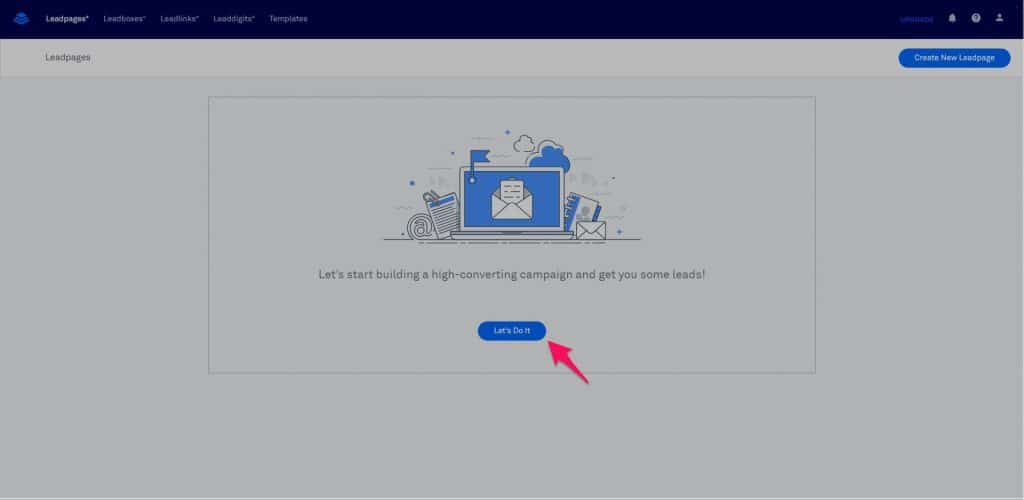
To start your first landing page, click the Let's Do It button. The site will walk you through the process by asking you questions about the nature of your landing page. You'll be given access to all the available Leadpages templates not long after. Alternatively, you can access the templates directly through the navigation bar.
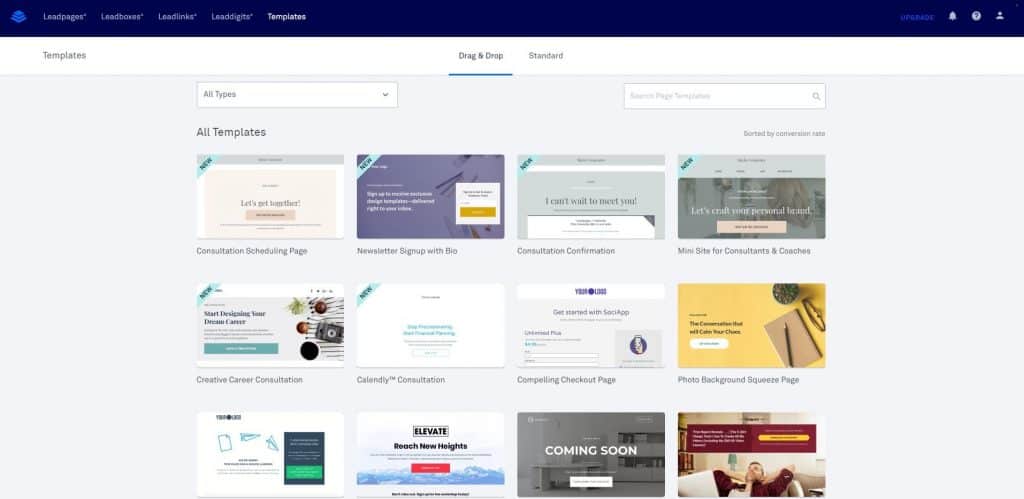
At this point, it is important to note that there are two types of templates available when you create landing pages. First, you have drag-and-drop landing page templates that are more customizable and modern. Then you have your standard templates that are tried and tested to guarantee high conversion rates.
How you create a new landing page will depend on what type of template you choose, either the templates you can change with the drag-and-drop editor or the standard templates with less ability to modify.
Standard templates
Standard templates are straightforward, with little room for modification. You will be able to edit the text and replace the sample images but won't be able to move any of the elements around. You can opt to hide any element you have no use for, but users need to do so with caution. Hiding elements can lead to noticeably empty spaces.

You can toggle the navigation buttons to preview what the landing page would look like on a tablet or phone.

To add SEO and tracking information, simply click the Lead Page Options button located on the left-hand sidebar. Use this to add metadata information as well as tracking codes.

Once you're done, you can go ahead and save your work or have it published. If you haven't connected your email service provider with your Leadpages account by this point, you will be prompted to do so. You won't be able to save the emails you collect otherwise.
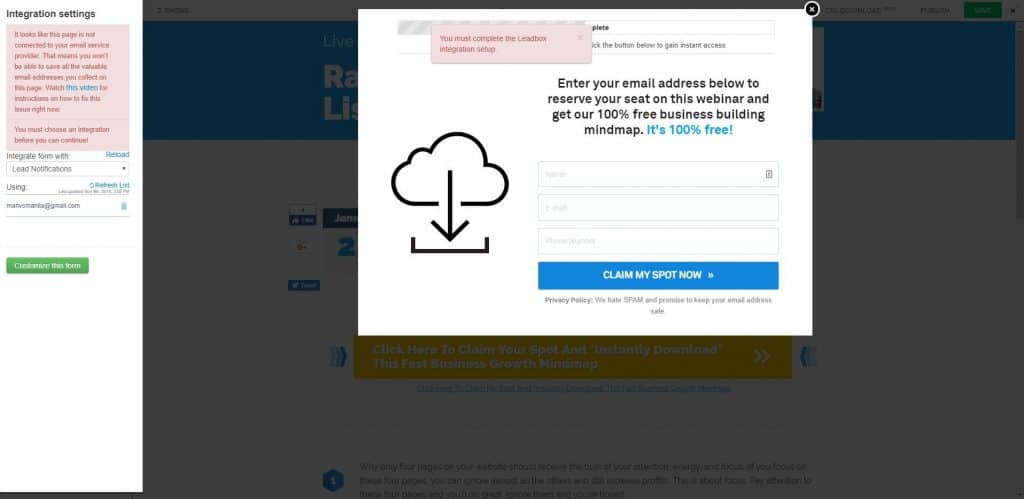
Drag-and-drop templates
Drag-and-drop templates work a bit differently. Right off the bat, you'll notice that you have more options. The sidebar houses four buttons: widgets, web page layout, page style, and page tracking.
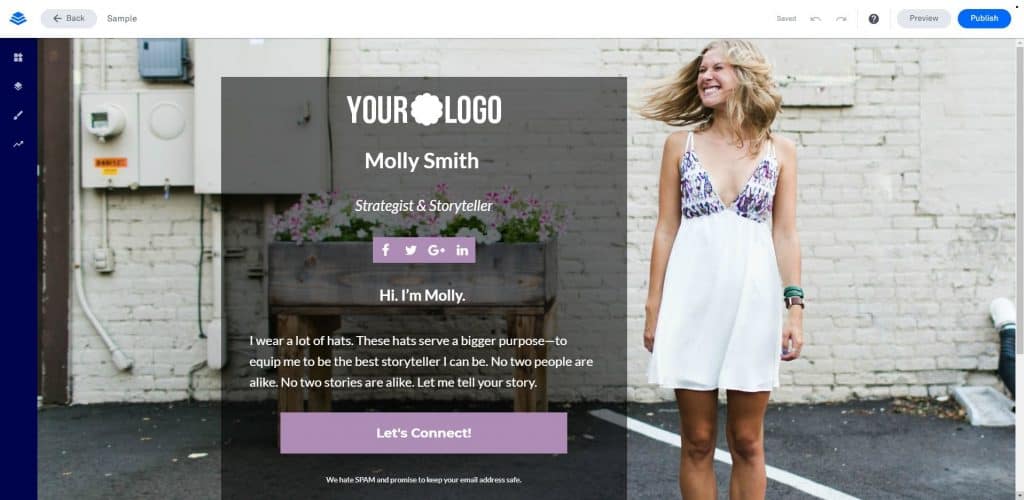
By dragging and dropping widgets to your landing page, you can insert new elements to edit. You can add headlines, text, images, videos, buttons, and more. It is here where you'll encounter one of Leadpages' most notorious kinks. The site's drag-and-drop functionality is flawed.

Placing elements where you want them can be a pain. For starters, you can only place them in areas that the template allows you to. There are grids where widgets can be inserted, while other areas are off-limits. Then there's the issue of precision. The widgets tend to snap into place. And as is the case during our testing, they end up nowhere near their intended destination.

Decent alternatives to Leadpages's page builder are Clickfunnels and GrooveFunnels. They're a little bit more user-friendly with their page builder, and it's a bit more intuitive, but they're more pricey. Check out our Clickfunnels review.
Editing the text and images, however, is a breeze in these landing page templates. Simply click on any placeholder text and replace the existing one with yours. You can resize and move elements around.
Page Layout lets you make changes to each section of your landing page. Here you can fine-tune the looks of your page as you would through CSS, only simpler.
For example, clicking on the Page Layout icons shows you the different sections the page has. With this template, there are two sections – the content body and the footer.
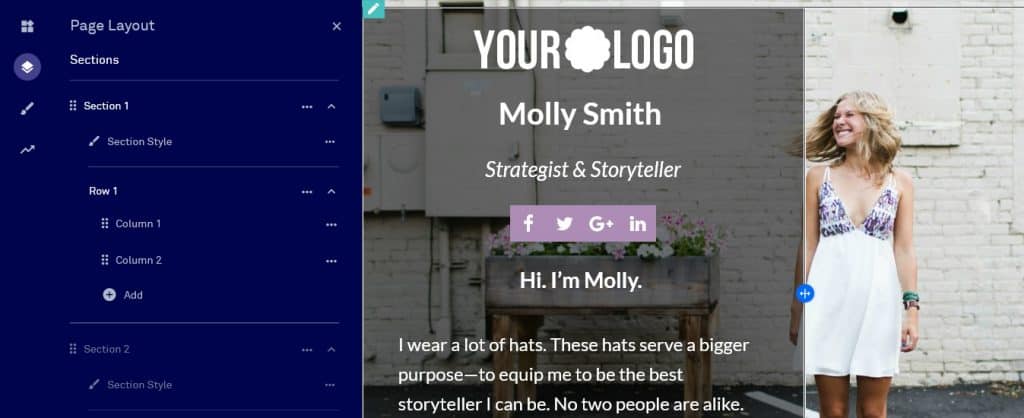
If you want to change the background, click on “Section Style” and make the necessary changes from here.

Page Style lets you play with your font as well as add custom CSS for more advanced users.

Page Tracking works the same way as in standard templates. Only this time, you can integrate it with Facebook and Google Analytics.
Once you're done, you can go and publish your landing page.

You'll find all your saved landing pages in the dashboard. You can go back and make more edits, rename the file, create a split test (A/B testing), duplicate the landing page, or have it deleted.
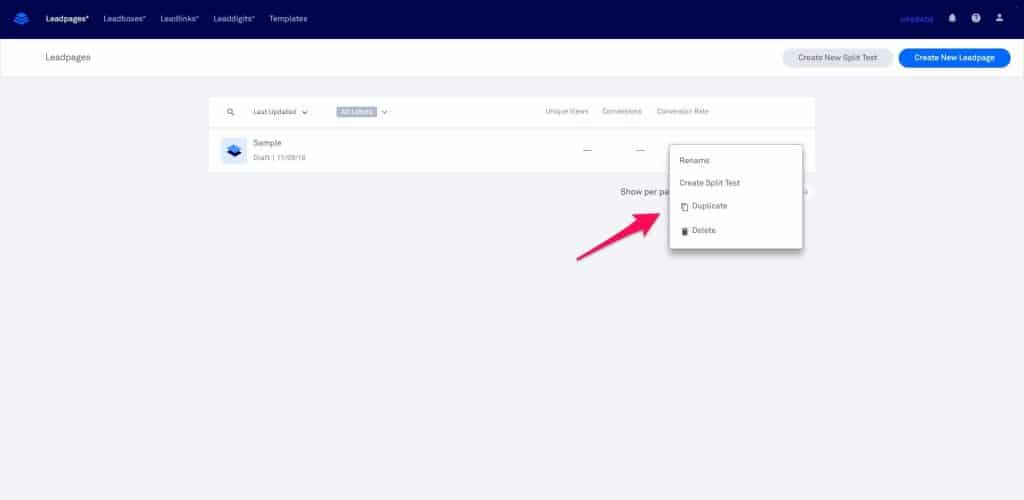
Split testing is only available for Pro and Advanced plan members.
Publishing
You can publish your landing pages on their own or under your domain name. However, publishing under a subdomain can potentially turn off your audience. It's advised that you publish under your own domain.
To do that, click on the user icon on the top-right part of the screen to open the drop-down menu. Choose “Domains” to load the page where you can connect your own domain.
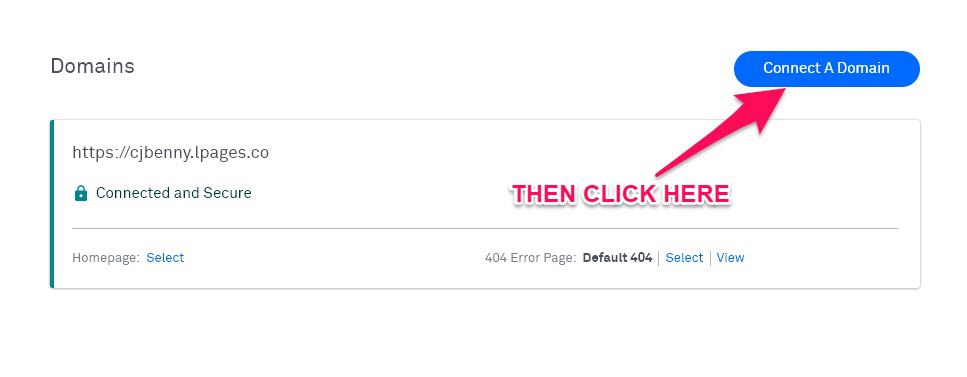
From here, Leadpages will guide you through the process of connecting your domain.
The dynamic HTML options let you publish the landing page on any website. However, there are ways to integrate the tool in other CMS like WordPress, Squarespace, and other popular content management systems.
Think Leadpages would be a good fit for you? Make sure before you pay. Click here to try Leadpages free for 2 weeks before paying.
Try Leadpages free and convert betterLeadpages Review: Pricing
Users can subscribe on a monthly, annual, or two-year basis, with the two-year plan being the most cost-efficient, provided you're in for the long haul. There are three tiers to choose from: Standard, Pro, and Advanced.

At $37/month, Leadpages pricing is affordable enough for startups and one-man showrunners. The benefits of being able to design and deploy landing pages for lead generation make up for the cost. But $48/month can be a steep price to pay given the small perks you unlock at that level. Unless you have a real need for online sales and payments and A/B testing, you're better off with the most basic plan. It should also be enough to help you earn more with your blog or site.
Leadlinks and Leaddigits are also unavailable unless you subscribe to the pro or advanced plan, which is a real bummer.
Customer support
Customer support does exist but priority is given to advanced subscribers. They have access to a 1-on-1 Quick Start Call as well as free virtual workshops. Those under the standard plan will have to make do with chat support (9 AM to 5 PM Central time during weekdays) or open a support ticket.
Leadpages Review: Verdict
Leadpages is a good deal for startups given the reasonable $37 entry point. If you need sleek, responsive landing pages quickly and would help you improve your conversion funnel and make more money from your website, the tool will be more than capable of delivering just that. However, there are plenty of other landing page builders out there that do pretty much the same thing. Maybe not on the same level, but you do have options.
Try Leadpages for 14 Days Free Right Here!
Get a 14 Day Free Trial of Leadpages HereLarge-scale businesses will likely have in-house solutions to create landing pages for their lead-generation campaigns. The $199/month advanced plan seems too steep of a price point, even for big corporations.
The good thing about Leadpages is that they have a free 14-day trial period to check the tool out for yourself (though you do need to provide your credit card information). While Leadpages does have its merits, the abundance of the best landing page builder solutions out in the market, along with the quirks of Leadpages' builder tool, makes it challenging to recommend.
Want to learn step-by-step how I built my Niche Site Empire up to a full-time income?
Yes! I Love to Learn
Learn How I Built My Niche Site Empire to a Full-time Income
- How to Pick the Right Keywords at the START, and avoid the losers
- How to Scale and Outsource 90% of the Work, Allowing Your Empire to GROW Without You
- How to Build a Site That Gets REAL TRAFFIC FROM GOOGLE (every. single. day.)
- Subscribe to the Niche Pursuits Newsletter delivered with value 3X per week
My top recommendations


















1 Comment
Conversation
I actually heard about LeadPages quite a while back (Back when Thrive wasn’t a thing). Glad to see they are still at the top of their game. The fact that LeadPages gives you a chance of connecting your domain with them is awesome. Thrive Architect actually uses a lot of code that can potentially slow the website down. Does publishing HTML codes on the website slow the website down with leadpages too? Or is the coding clean in their case?